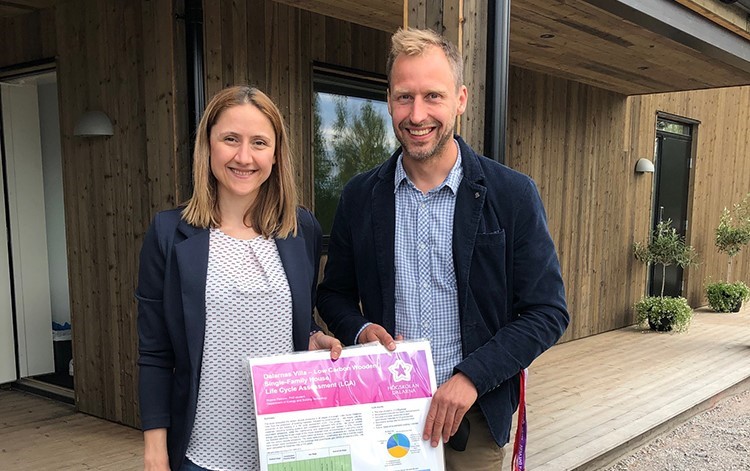Dalarnas Villa - Built Research Project Investigating Sustainability
Created on 04-06-2022 | Updated on 20-05-2023
Dalarnas Villa is a two-storey wooden single-family house in the region of Dalarna, Sweden. It was designed and built with the aim of reducing negative environmental impacts, enhancing energy efficiency, and creating a healthy indoor space for its occupants. The project also aimed to test various solutions to prevent fire, housebreaking, damp, and water-related damages in Swedish houses. Thus, the home was built using eco-friendly materials and equipped with energy systems and smart control systems to have a positive impact on both the outdoor environment (by reducing CO2 emissions and promoting energy savings) and the indoor environment (by improving air quality and ventilation).
This project is a result of a collaboration between Dalarna University and several partners, namely the insurance company Dalarnas Försäkringsbolag, local manufacturers such as Fiskarhedenvillan AB, and building material and systems suppliers. The project is as a test prototype or a living lab for research. In 2019, it was awarded the Nordic Swan Ecolabel which is the Nordic official environmental label.
Architect(s)
Dalarna University
Location
Dalarna region, Sweden
Project (year)
2017
Construction (year)
2019
Housing type
single-family housing
Urban context
-
Construction system
wooden system
Status
Built
Reference documents
Dalarnas Villa building components and materials adapted from (Magnusson, 2020; Petrović et al., 2021)
ViewDescription
In the Nordic countries, water-related damages in buildings (including homes) result in annual costs of several billion euros. These damages emerge from leaks in piping systems, inadequately waterproofing wet room layers, or damp-related problems which also negatively impact indoor air quality and occupants’ health. Some measures can be implemented to enhance the building sustainability that could result in huge savings and have a better impact on the environment and occupants’ health.
The Swedish insurance company “Dalarnas Försäkringsbolag” decided to finance this research project to look for solutions to foment a more economically and environmentally sustainable future for housing (Magnusson, 2020; Petrović et al., 2021). In collaboration with the Dalarna University, a design competition for students was announced in 2017 (Dalarna University, 2020). The winning team proposed an aesthetically pleasing design which was also rational and sustainable. In 2019, Dalarnas Villa was constructed by high school students under the supervision of local entrepreneurs. Currently, it is rented out to a Swedish family (Dalarna University, 2020). The Dalarnas Villa received the Nordic Swan Ecolabel which is the Nordic official environmental label (Holén, 2019; Svanen, n.d.).
Construction and materials
Dalarnas Villa was an opportunity to test the use of sustainable materials and smart systems to augment safety and save energy by way of cost-effective solutions with less negative environmental impact (Magnusson, 2020; Petrović et al., 2021). Wood is considered to be a sustainable option in Sweden. Thus, the house structure system is based entirely on wood. For the façade, wood panels were utilized as well. For the energy and smart systems, they installed photovoltaic panels on the southwest side of the roof; an exhaust air circulation system, and a ground source heat pump. Each year, a new ventilation system is installed to test different solutions to improve indoor air quality and provide energy savings. For safety systems that mitigate water-related damages, they used a smart water control system. It has a switch that detects, alerts, and closes the water supply if there is a leak, no occupants in the house, and/or in case of potential risk or damage due to water freezing (Dalarna University, 2020; Magnusson, 2020; Petrović et al., 2021).
Life Cycle Costs assessment
Life Cycle Costing (LCC) calculates the costs that are incurred during the pre-construction and construction phases (known as initial costs) and the future maintenance and operational costs (Estevan & Schaefer, 2017). LCC applies discounts and inflation rates to keep future costs in line with those of today. In other words, to bring all initial and future costs over a project lifetime into a single time dimension (Jawad & Ozbay, 2006).
Petrović et al., (2021) conducted LCC analysis for the Dalarna Villa from cradle to grave following the lifetime structure of EN 166 27 standard. Over a 50-year lifespan, a discount of 7% and an inflation rate of 2 % and adding the taxes, the life cycle costs of the Villa accounted for 3,588 euro/m2. LCC conducted the study for 50- and 100-year lifespans as well as different inflation and discount rates. Over the two life spans, a common pattern has been detected:
- The investment-related costs had the highest share. Within these investment-related costs, labour amounted to half of the costs in this life cycle stage, followed by building materials, installations, and other pre-construction costs. This resonates with the ongoing issue of labour availability and the rise in construction prices in Europe as shown in the Eurostat chart presenting the EU construction prices and costs index (CCI) (Eurostat, 2021). This high percentage emphasizes the crucial potential of the industrialized construction sector to reduce construction labour (Qi et al., 2021), which is the research focus of ESR 01.
- The running costs during the occupation phase - when residents were living in the house - included maintenance, replacement, operational energy and operational water costs. In this phase, maintenance costs were the highest, followed by replacement costs. After 50 years, both maintenance and replacement costs significantly increase, while the operational energy and operational water costs rise slowly (Petrović et al., 2021). The study also showed that without installing PV panels, the operational energy use costs would almost double over the 100 year lifespan.
- For the end-of-life costs, the study assumed the villa would be demolished. Thus, these costs were the only value that is decreasing over the 100-year life span. If it were designed to be dismantled, the end-of-life costs would increase, but the solution would be more sustainable with regard to resource efficiency and environmental impact (Petrović et al., 2021). Design for disassembly is the research focus of RE-DWELL ESR01 project.
Over a 100-year lifespan, the initial costs of pre-construction and construction accounted for almost 75% of the total LCC, while the operational costs of maintenance, energy and water accounted for almost 25% (Petrović et al., 2021).*
Environmental impact
The carbon footprint of building materials can be understood through the so-called Global Warming Potential (GWP). It is an indicator of the amount of the greenhouse gases (GHG) that trap heat in the atmosphere (Durkee, 2006). This amount is explained in comparison with a reference gas which is carbon dioxide. Petrovic et al., (2019) carried out Life Cycle Assessment (LCA) with a focus on the villa building materials and their transportation distance to understand their environmental impact. The study calculated the GWP using One Click LCA software. The conclusions were that the thermo wood material used in the exterior envelope releases the highest amount of GHG to the atmosphere compared to the other materials which account for 514.03 Kg CO2e/m3. The next materials were concrete, cross-laminated timber (CLT) and the triple glazed windows releasing 268.68 Kg CO2e/m3, 140 Kg CO2e/m3 and 115 Kg CO2e/piece respectively (Petrovic et al., 2019). On the other hand, the wood-based materials for the structure and envelope are lower in GWP where each account for 25 Kg CO2e/m3. Thus, they can be considered more environmentally friendly.
Dalarnas Villa is a pilot project to investigate sustainable housing solutions in Sweden; houses that prioritise the quality of the indoor environment, the health of the residents and the impact on global warming. However, one of the questions to be addressed in the future is whether the increased costs of sustainable solutions will be cost-effective in the long term, as residents will pay less for maintenance and energy costs.
Alignment with project research areas
“Design, planning, and building” as a research area of RE-DWELL is concerned with the affordability of the design of sustainable housing and its construction for both housing providers and future dwellers. This case study gives an example of the life cycle costs of a sustainable house that corelates with this research area. The Dalarnas Villa project aimed to use eco-materials and investigate sustainable solutions for houses in Sweden. This villa project design and construction resulted in reduced running costs for occupants, however, the investment costs (pre-construction and construction) occupied the highest percentage of the villa life cycle costs over the 100-year lifespan. Understanding this rise in the initial costs, highlights some of the issues facing the provision of sustainable, healthy, and affordable housing. It is important to understand the impact of long-term sustainable solutions in reducing negative impacts on climate, recurring maintenance, and operational costs.
Another area of research by RE-DWELL is “Community participation”, which came into play at various stages of the realisation of the Dalarnas Villa project. This can be seen in the collaboration between the insurance company Dalarnas Försäkringsbolag and Dalarnas University. The company is funding the design and construction of this project to act as a living villa laboratory. The company wanted to look for sustainable solutions for the Swedish community to overcome some of the most common and financially disruptive problems, albeit for residents or insurance companies. The project involved the participation of university students in the design of the villa. The villa was also built with the help of high school students and local suppliers and equipped by smart solutions from local businesses.
* This diagram is for illustrative purposes only based on the author’s interpretation of the above case study
Alignment with SDGs
SDG 3 Good Health and Wellbeing
SDG 7 Affordable and Clean Energy
SDG 9 Industry, Innovation, and Infrastructure
SDG 11 Sustainable Cities and Communities
SDG 12 Responsible Consumption and Production
SDG 13 Climate Action
The Dalarnas villa presents an example of a sustainable healthy house. It is aligned with various Sustainable Development Goals (SDGs). The design and construction of this house is consistent with SDG 3 Good Health and Wellbeing for the following reasons: The design respects and integrates the surrounding nature and creates a pleasant sense of space through large glass windows. The house serves as a living laboratory to test new ventilation systems that improve indoor air quality, save energy and help reduce damp-related damage to the house. The use of photovoltaic panels, energy control systems, water control systems and heat pump systems contribute to SDG 7 Affordable and Clean Energy and SDG 9 Industry, Innovation, and Infrastructure.
The Dalarnas Villa project is the result of a local collaboration between Dalarnas University, local businesses, and suppliers. Young students from the university designed the villa and secondary school students participated in its construction to learn building techniques. The aim of this collaboration was to present the prototype of a sustainable house with the following characteristics: (1) environmentally sustainable using eco-materials that have less negative impact on the environment and global climate; (2) economically sustainable to save recurrent maintenance costs for water-related damages and be energy efficient; and (3) socially sustainable by relying on local cooperation and using new systems that enhance indoor air quality that would have a positive impact on the health and well-being of the residents. These characteristics are closely related to SDG 11 Sustainable Cities and Communities, SDG 12 Responsible Consumption and Production, and SDG 13 Climate Action.
*Note: these values are extracted from Figure 8 chart of the study (Petrović et al., 2021)
References
Dalarna University. (2020). Opening of Dalarnas Villa - Result of Collaboration. Dalarna University Official Website. https://www.du.se/en/about-du/news-and-events/news/opening/
Durkee, J. (2006). US and global environmental regulations. Management of Industrial Cleaning Technology and Processes, 43–98. https://doi.org/10.1016/B978-008044888-6/50016-8
Estevan, H., & Schaefer, B. (2017). Life Cycle Costing - state of the art report. ICLEI – Local Governments for Sustainability, European Secretariat, 50. http://www.sppregions.eu/fileadmin/user_upload/Life_Cycle_Costing_SoA_Report.pdf
Eurostat. (2021). Construction producer price and construction cost indices overview. https://ec.europa.eu/eurostat/statistics-explained/index.php?title=Construction_producer_price_and_construction_cost_indices_overview
Holén, E. (2019). The Pihlblad family moves into a research villa. https://www.svanen.se/en/news/2019/juni/the-pihlblad-family-moves-into-a-research-villa/
Jawad, D., & Ozbay, K. (2006). The Discount Rate in Life Cycle Cost Analysis of Transportation Projects. 85th Annual Meeting of the Transportation Research Board, 1–19.
Magnusson, B. (2020). Dalarna’s Villa Offers Useful Lessons. Effect4buildings. https://www.effect4buildings.se/dalarnas-villa-offers-useful-lessons/
Petrovic, B., Myhren, J. A., Zhang, X., Wallhagen, M., & Eriksson, O. (2019). Life cycle assessment of building materials for a single-family house in Sweden. Energy Procedia, 158, 3547–3552. https://doi.org/10.1016/j.egypro.2019.01.913
Petrović, B., Zhang, X., Eriksson, O., & Wallhagen, M. (2021). Life cycle cost analysis of a single-family house in Sweden. Buildings, 11(5). https://doi.org/10.3390/buildings11050215
Qi, B., Razkenari, M., Costin, A., Kibert, C., & Fu, M. (2021). A systematic review of emerging technologies in industrialized construction. Journal of Building Engineering, 39(October 2020), 102265. https://doi.org/10.1016/j.jobe.2021.102265
Svanen. (n.d.). The history of the swan. The Nordic’s Official Environmental Label - The Swan. Retrieved October 18, 2022, from https://www.svanen.se/svanens-arbete/svanens-historia/
Related vocabulary
Life Cycle Costing
Area: Design, planning and building
Created on 05-12-2022
Read more ->








